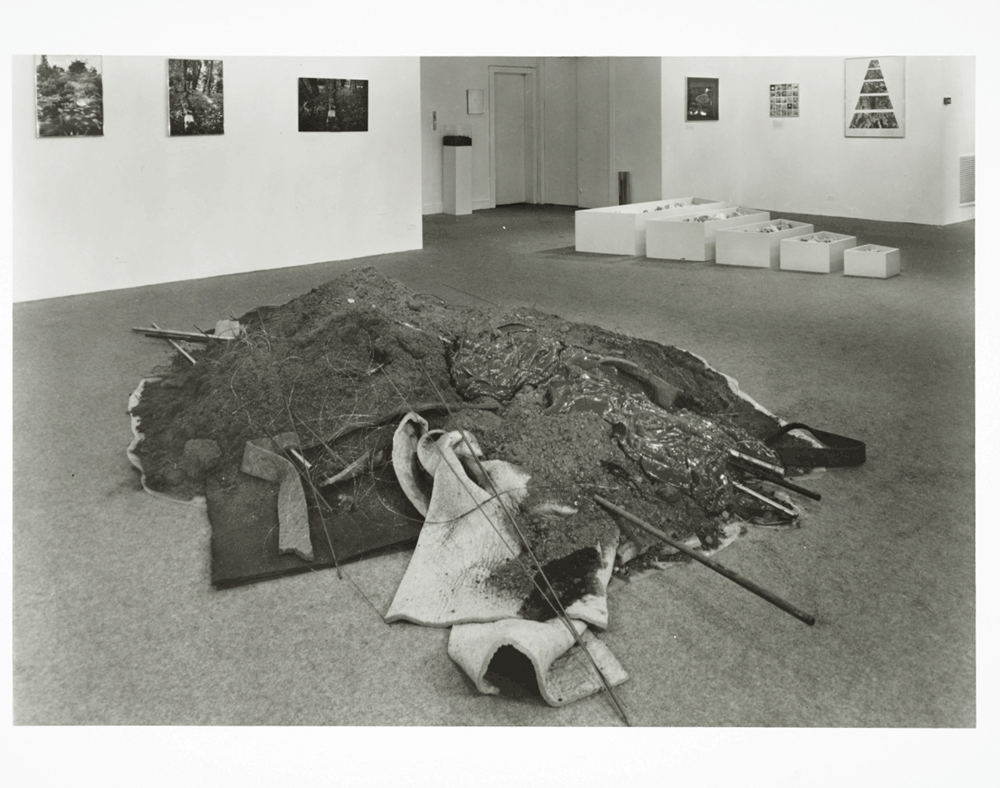
Video still from Uriburu’s Colorations. © Nicolás García Uriburu.
Shown here, at maat ext. Cinema, from 29 April to 30 July 2022.

Documentation of Nicolás García Uriburu’s intervention on the sidelines of the 34th Venice Biennale, in 1968, and other projects.
ECHOING THE GROUNDWORKS TIMELINE AND THE VISUAL NATURES MAPPING: 1968
On 19 June 1968, at the 34th Venice Biennale, Nicolás García Uriburu made an intervention with a protest against both the biennale and the destruction of our planet by colouring the Venetian canals green with an organic fluorescent dye – fluorescein, developed by NASA. Restoring it thereby to a more natural colour without causing harm to the life present in the canal, García Uriburu's performance at once denounced the human action that has discoloured the canals for centuries and constituted a sharp critique of the art institutions of the 1968 Venice Biennale. Performed at the biennale but without the knowledge or support of the organisation, the Coloration of the Grand Canal, Venice was just the first of many such performances, documented by the artist through photography, film and by storing bottles of the fluorescent water.
In 1973, García Uriburu published Portfolio (Manifesto) as part of the documentation of his colouration works in an edition of 111. One of the screenprints reads:
JUNE 19 1968. FIRST PROJECT. GREEN VENICE.
SPACE:
ART WORK HAS NO AUTONOMOUS FORM ANY MORE.
ART WORK ADOPTS NATURE FORM: FLUID, DYNAMIC.
ART WORK HAS NO MORE PLACE OUTSIDE OF NATURE: (GALLERY, MUSEUM...) ITS PLACE ITS INSIDE OF NATURE.
ART WORK HAS NO AUTONOMOUS DIMENSIONS ANY MORE: DEPENDS OF THE ENVIRONMENT, THE CITY AND THE WATERWAYS.
ART WORK DOES NOT START FROM A PARTICULAR SYSTEM OF COMMUNICATION FOR ITS DIFFUSION: IT SURPRISES THE PUBLIC IN HIS OWN VITAL SPACE.
TIME:
ART WORK EXISTS ONLY FROM THE MOMENT OF ITS INTEGRATION WITH REALITY: THE RED PIGMENT TRANSFORMS WATER IN GREEN ART WORK.
ART WORK HAS LIFE: BEGINNING AND END. IT CHANGES PLACE, FORM, DIMENSION AND GETS CALM (IT VARIES ACCORDING TO METEOROLOGY, TIDES, FLOWS...)
URIBURU


Top: Coloration of the Grand Canal, Venice, 1968, chromogenic print. © Nicolás García Uriburu, Uriburu Foundation Collection. Under: Video stills from Uriburu’s Colorations. © Nicolás García Uriburu.
Nicolás García Uriburu, Coloración en Venecia, 1968, manipulated photograph and typed text, 82 × 50 cm. Colección Museo Nacional de Bellas Artes, Buenos Aires, retrieved here April 2022.
Nicolás García Uriburu (Argentina, 1937–2016) was an artist, ecologist and architect. He studied architecture at the University of Buenos Aires while developing his artistic practice, and held his first solo exhibition at the Müller Gallery in 1954. In 1965, he received the Braque Prize and moved to Paris with his wife, where he won the 1968 Grand Prize at the National Salon of Plastic Arts with a painting engaged with pop aesthetics and showcased an installation with animals and acrylic plants in an exhibition entitled Prototypes for an Artificial Garden (1968). That very year, he carried out his first intervention in nature with Coloration of the Grand Canal, Venice. García Uriburu is also a founding member of Grupo Bosque, with which he participated in reforestation campaigns and joint action with Greenpeace.
Visual Natures (maat, 30/03–05/09/2022) is the product of more than two years of critical investigations around climate science, creative practices and eco-politics. A continuation of the data-driven installation Earth Bits – Sensing the Planetary and the public programme Climate Emergency > Emergence, both conceived and ignited by Beatrice Leanza during her directorship of the museum, the project surveys political, social and cultural forms of collective agency from the 1950s onwards that demonstrate how our understanding of “nature” informs the ways in which we organise, sustain and govern our communities as an expanding planetary construct, in concept and in practice.
On maat ext., the series #groundworks introduce the critical explorations that feed into the complex interconnectivity between the environmental and energetic quests and its reverberation through decades of artistic creation and cultural dynamics, traced from the 1950s until today, and continues these investigations through collaborations with artists, curators, archivists, researchers and activists on their work and the meanings of ecology, environmentalism and societal responsibilities in the face of climate change.
Explorations is a programme framework (maat, 2020–2022) featuring a series of exhibitions, public and educational projects delving into the multi-faceted subject of environmental transformation from various scholarly and experimental vantage points – it brings philosophical and political perspectives forward, as well as sociocultural and technological investigations interwoven in speculative and critical practices in the arts and design at large. Central to this discursive and critical effort was the establishment of the maat Climate Collective in 2021, chaired by T. J. Demos, and geared toward assembling diverse cultural practitioners working at the intersection of experimental arts and political ecology.











